
Menu:
Instrumentation
I have engineered and fabricated many cryogenic, mechanical, optical, vacuum, electronic, and computer-controlled systems. For the development of novel measurement systems, the mathematical formalism is developed to model experimental data and characterize the system. Below is a sample of various instruments and components I have recently designed and built.
Automated optical and magneto-optical measurement system
.jpg) I fabricated hardware and developed software that integrates multiple optical systems, cryogenic systems, and hardware components into a fully automated platform for optical and magneto-optical measurements. Our new helium recovery system and custom active feedback laser stabilization system opened the possibility of unattended (such as overnight and weekend) data acquisition resulting in more complete data sets, enhancement of signal-to-noise, and remarkable time savings for laboratory personnel. The system currently incorporates a Bomem DA8 FTIR spectrometer, an 8T Oxford magnet, Janis and Oxford continuous flow cryostats, a throttling helium exhaust manifold, temperature controllers, dual CW laser system, multiple motorized actuators and optical stages, and other miscellaneous hardware. Simple batch programs are generated by the user (with automatic error checking), hardware is protected by multiple layers of hardware and software interlocks, and the platform is easily expandable to accommodate other hardware.
I fabricated hardware and developed software that integrates multiple optical systems, cryogenic systems, and hardware components into a fully automated platform for optical and magneto-optical measurements. Our new helium recovery system and custom active feedback laser stabilization system opened the possibility of unattended (such as overnight and weekend) data acquisition resulting in more complete data sets, enhancement of signal-to-noise, and remarkable time savings for laboratory personnel. The system currently incorporates a Bomem DA8 FTIR spectrometer, an 8T Oxford magnet, Janis and Oxford continuous flow cryostats, a throttling helium exhaust manifold, temperature controllers, dual CW laser system, multiple motorized actuators and optical stages, and other miscellaneous hardware. Simple batch programs are generated by the user (with automatic error checking), hardware is protected by multiple layers of hardware and software interlocks, and the platform is easily expandable to accommodate other hardware.
Automation of experiments is not new. However, aspects of this project were particularly challenging: (1) control of a Bomem DA8 FTIR spectrometer (with antiquated hardware and software) and automatic conversion of SPC/IGM/IGN file types (2) protect an old Oxford superconducting magnet system with custom hardware and software interlocks from unattended power outages, low helium levels, and quenches (3) actuate a Janis cryostat by retrofitting a closed-loop stepper motor and gear system complete with limit and homing switches, fail-safes from power outages, and electrical isolation from (noisy) motor pulses (4) design and fabricate an automated throttling helium exhaust manifold that enables a full range of sample temperatures with minimal heater power for two continuous flow cryostats (5) incorporate a flexible scripting language and easily accommodate new hardware components to adapt to variability in experimental arrangement and procedures.
The new system was necessary for TaAs chiral pumping magneto-optical studies to attain requisite signal-to-noise levels. An overview of the system is presented here:
PDF: Summary of AutoScan version 2 (updated 10/31/17)
Helium recovery system
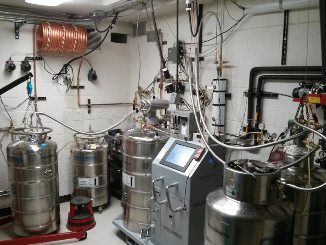 I designed and constructed a full laboratory helium recovery system that spans five laboratory spaces. The system includes a Cryomech Liquid Helium Plant capable of liquefying 25 liters per day, and incorporates many custom components like a high capacity water trap, central helium flow sensors (modified automotive mass-air-flow sensors), remote displays and alarms for oxygen sensors, active safety interlocks, and a large 3400 cu.-ft. recovery bladder that circumvents the need for a compressor and high-pressure storage tanks. A high degree of automation makes the system simple to operate with minimum user time involved in helium recovery, liquefaction, and transfer processes. A computer equipped with a general purpose DAQ card (with many analog and digital I/O's) reads gas and coolant temperatures, bladder pressure, cold-trap liquid nitrogen level, electrical power condition, helium gas flow rates, weight of dewars, mechanical interlock switches, and helium gas impurity levels. The computer controls many solenoids and power to equipment permitting automatic control of liquid nitrogen refills, dewar-to-dewar transfers, helium purity readings, bladder pressure/vacuum relief, electrical power to the closed-loop chiller and diaphragm pump, and flow of helium gas to the liquefier. Stasis modes of the entire recovery system are automatically activated and liquefaction automatically resumed. Such automatic control of the entire system is useful for circumstances like emptying the bladder, regenerating traps, maintaining the cold-trap and zero-loss recapture from mobile dewar blow-off, and reacting to faults detected in the system.
I designed and constructed a full laboratory helium recovery system that spans five laboratory spaces. The system includes a Cryomech Liquid Helium Plant capable of liquefying 25 liters per day, and incorporates many custom components like a high capacity water trap, central helium flow sensors (modified automotive mass-air-flow sensors), remote displays and alarms for oxygen sensors, active safety interlocks, and a large 3400 cu.-ft. recovery bladder that circumvents the need for a compressor and high-pressure storage tanks. A high degree of automation makes the system simple to operate with minimum user time involved in helium recovery, liquefaction, and transfer processes. A computer equipped with a general purpose DAQ card (with many analog and digital I/O's) reads gas and coolant temperatures, bladder pressure, cold-trap liquid nitrogen level, electrical power condition, helium gas flow rates, weight of dewars, mechanical interlock switches, and helium gas impurity levels. The computer controls many solenoids and power to equipment permitting automatic control of liquid nitrogen refills, dewar-to-dewar transfers, helium purity readings, bladder pressure/vacuum relief, electrical power to the closed-loop chiller and diaphragm pump, and flow of helium gas to the liquefier. Stasis modes of the entire recovery system are automatically activated and liquefaction automatically resumed. Such automatic control of the entire system is useful for circumstances like emptying the bladder, regenerating traps, maintaining the cold-trap and zero-loss recapture from mobile dewar blow-off, and reacting to faults detected in the system.
Since there are many hardware components and automated features, a comprehensive overview is posted on as a pdf file and (a rougher draft) on set of web pages:
PDF: Summary of the Helium Recovery System (updated 06/15/17)
A brief video shows the scope of the fabrication and construction:
Building a helium recovery system (5 minutes long)
8T Oxford magnet system rebuild
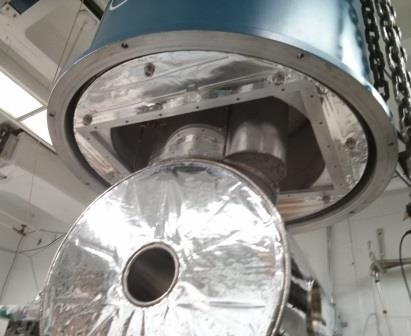 Magneto-optical measurements rely on an Oxford split-coil superconducting magnet to study materials in fields up to 8T. Before implementing modifications, the magnet system vaporized liquid helium at a very high rate, provided an unstable optical platform for samples and windows, caused misalignment of optical elements upon cooling, attained minimum sample temperatures of 6K, and rapidly leaked helium exhaust gas from the helium reservoir (in many places) preventing helium recovery. Redesigning the magnet system to overcome these short-comings involved considering many issues: radiant and thermal conduction, thermal contraction, vacuum loading, forces generated by magnet quenches, and asymmetric geometrical constraints with small clearances. Thermal and mechanical analyses were performed to minimize thermal loading effects while providing a stable optical platform.
Magneto-optical measurements rely on an Oxford split-coil superconducting magnet to study materials in fields up to 8T. Before implementing modifications, the magnet system vaporized liquid helium at a very high rate, provided an unstable optical platform for samples and windows, caused misalignment of optical elements upon cooling, attained minimum sample temperatures of 6K, and rapidly leaked helium exhaust gas from the helium reservoir (in many places) preventing helium recovery. Redesigning the magnet system to overcome these short-comings involved considering many issues: radiant and thermal conduction, thermal contraction, vacuum loading, forces generated by magnet quenches, and asymmetric geometrical constraints with small clearances. Thermal and mechanical analyses were performed to minimize thermal loading effects while providing a stable optical platform.
Completely encasing the magnet in a low-emissivity LN shield decreased the liquid helium boil-off rate by a factor of 6. The LN shield inside the magnet bores provides convenient mounting of cold windows. A new actuated clamping collet that engages the sample cold-finger is mounted to the liquid nitrogen shield, and lowered the minimum sample temperature to less than 2K. The sample is optically stable and rigid with respect to the vacuum jacket. The entire optical path is therefore locked to the optics table, and does not change upon cooling the sample or magnet.
The 35 mechanical drawings of the modifications are downloadable: Mechanical Drawings - Oxford Magnet Mods
Complex Faraday And Kerr angle measurement system
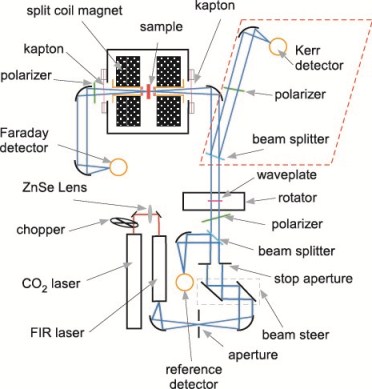 A novel magneto-optical measurement system was designed and built. The polarization-modulation technique and detection scheme is sensitive to the phase and amplitude of the electric field. A far-infrared (THz) system measures the full complex Faraday and Kerr angle, the rotation as well as circular dichroism, with an unprecedented accuracy. Utilized in condensed matter systems, the spectral dependence of the complex Hall conductivity is measured. A CO2 laser pumps a fabricated THz laser with lines covering the spectral range from 0.3 to 6 THz. The complex Faraday and Kerr angles are measured as a continuous function of temperature from 2 to 310 K and applied fields up to 8 T. The designed and fabricated tunable THz continuous-wave molecular laser includes a fabricated output coupler and laser-gas recovery system. The dual-laser system includes custom computer-controlled feedback stabilization. The instrument design and components have been adopted by multiple research laboratories.
A novel magneto-optical measurement system was designed and built. The polarization-modulation technique and detection scheme is sensitive to the phase and amplitude of the electric field. A far-infrared (THz) system measures the full complex Faraday and Kerr angle, the rotation as well as circular dichroism, with an unprecedented accuracy. Utilized in condensed matter systems, the spectral dependence of the complex Hall conductivity is measured. A CO2 laser pumps a fabricated THz laser with lines covering the spectral range from 0.3 to 6 THz. The complex Faraday and Kerr angles are measured as a continuous function of temperature from 2 to 310 K and applied fields up to 8 T. The designed and fabricated tunable THz continuous-wave molecular laser includes a fabricated output coupler and laser-gas recovery system. The dual-laser system includes custom computer-controlled feedback stabilization. The instrument design and components have been adopted by multiple research laboratories.
Gate-modulated magneto-optical measurement systems
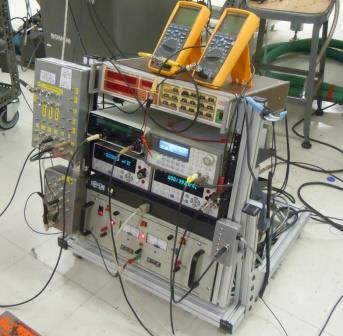 The above magneto-optical techniques that include measurement of the complex Faraday/Kerr angle and cyclotron resonance were modified to greatly enhance the sensitivity todetect surface electronic states of materials under study. By incorporating gate-modulation with concurrent dynamic dc-gating, surface state effects are isolated from the bulk response. As demonstrated in measurements of Bi2Se3 (bulk crystals and films), the topological surface state transport properties were measured as a function of Fermi level from the Dirac point up through the conduction band edge. Modifications to the cryostat allow high voltage gating, concurrent dc transport measurements, and dynamic in situ capacitance measurements.
The above magneto-optical techniques that include measurement of the complex Faraday/Kerr angle and cyclotron resonance were modified to greatly enhance the sensitivity todetect surface electronic states of materials under study. By incorporating gate-modulation with concurrent dynamic dc-gating, surface state effects are isolated from the bulk response. As demonstrated in measurements of Bi2Se3 (bulk crystals and films), the topological surface state transport properties were measured as a function of Fermi level from the Dirac point up through the conduction band edge. Modifications to the cryostat allow high voltage gating, concurrent dc transport measurements, and dynamic in situ capacitance measurements.
Multiple gating techniques compatible with THz measurements which provide large break-down voltages and extremely uniform gating over large areas (cm2) have been designed and developed. Semitransparent gates fabricated by ion implantation in high resistivity SiO2/Si substrates (used in graphene studies) function at low temperature. The organic dielectric Parylene-C conformal coatings together with semitransparant NiCr top-gates provide a very general technique to gate most any material uniformly, even extremely irregular surfaces. F4TCNQ molecules, whose high electron affinity chemically dopes surfaces, were thermally evaporated onto materials, overcoated with parylene-C, and conventionally gated in Kerr modulation experiments. Solid poly-ethylene oxide (PEO) matrix containing LiClO4 acts as a solid electrolytic capacitor capable of transferring a large amount of charge and is transparent over a broad THz spectral region.
Gate-modulated continuous-scan FTIR spectroscopy
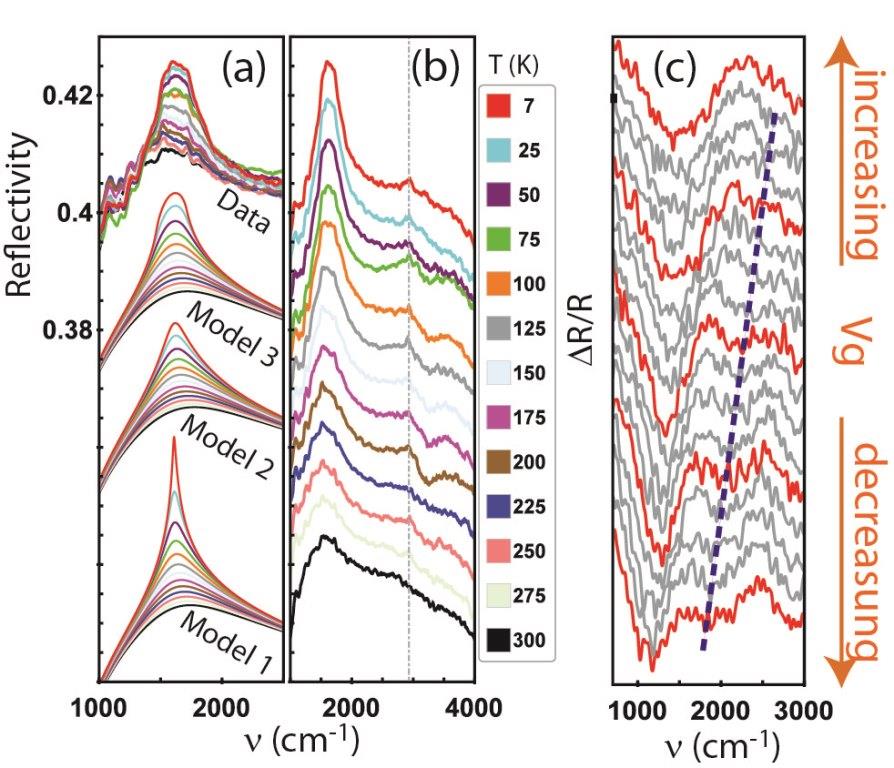 Semi-transparent gate-modulation techniques were extended to FTIR spectroscopy. The gate is modulated at a high frequency f0 compared to the bandwidth Df of the FTIR modulations. Strong (high order) bandpass filtering over a bandwidth Df centered on f0 results in an interferogram that encodes only the modulated surface signals. The sensitivity to surface signals is enhanced by 2-orders of magnitude compared to dc-gating, allowing the surface effects of Cd3As2 to be measured as a function of dc-gate voltage. Panel (c) shows the gate-modulated reflection spectrum. A surface feature (following the purple dotted line) sweeps through the spectral range as dc-gate voltage is varied, showing the surface is heavily accumulated.
Semi-transparent gate-modulation techniques were extended to FTIR spectroscopy. The gate is modulated at a high frequency f0 compared to the bandwidth Df of the FTIR modulations. Strong (high order) bandpass filtering over a bandwidth Df centered on f0 results in an interferogram that encodes only the modulated surface signals. The sensitivity to surface signals is enhanced by 2-orders of magnitude compared to dc-gating, allowing the surface effects of Cd3As2 to be measured as a function of dc-gate voltage. Panel (c) shows the gate-modulated reflection spectrum. A surface feature (following the purple dotted line) sweeps through the spectral range as dc-gate voltage is varied, showing the surface is heavily accumulated.
CW THz molecular gas laser system
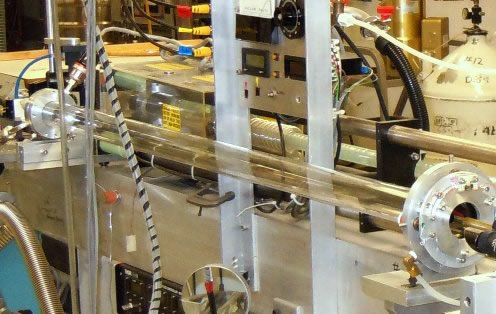 I designed and built a far infrared (THz) continuous wave laser used in many studies of condensed matter systems as well as development of novel carbon-based THz detectors and emitters. The laser operates in the spectral range between 1mm to 50 um with a maximum output of 50 mW. The laser incorporates a Vycor dielectric waveguide that favors the TEM-00 mode thereby minimizing modal power fluctuations that register as phase noise in the signal. The FIR laser is pumped by a tunable CO2 laser operating in the range of 9.2 to 10.8 um with a maximum output of 50W. A ZnSe Brewster window minimizes back reflections into the pump laser.
I designed and built a far infrared (THz) continuous wave laser used in many studies of condensed matter systems as well as development of novel carbon-based THz detectors and emitters. The laser operates in the spectral range between 1mm to 50 um with a maximum output of 50 mW. The laser incorporates a Vycor dielectric waveguide that favors the TEM-00 mode thereby minimizing modal power fluctuations that register as phase noise in the signal. The FIR laser is pumped by a tunable CO2 laser operating in the range of 9.2 to 10.8 um with a maximum output of 50W. A ZnSe Brewster window minimizes back reflections into the pump laser.
The FIR laser is equipped with custom input and output couplers, gas recovery and reuse system, novel Fabry-Perot resonator that measures the lasing frequency, and belt driven dc-motor in conjunction with piezo-electric stacks that permit translating and tuning the laser cavity. Computer-controlled PID active feedback stabilizes the two-laser system. A modulating voltage is applied to the CO2 piezo-electric stack that dithers the output coupler while the signal output level of the FIR laser is monitored. The phase and amplitude of the second harmonic of the applied modulation is used to tune the dc voltage level of the CO2 piezo-electric stack.
Step-scan FTIR spectrometer system
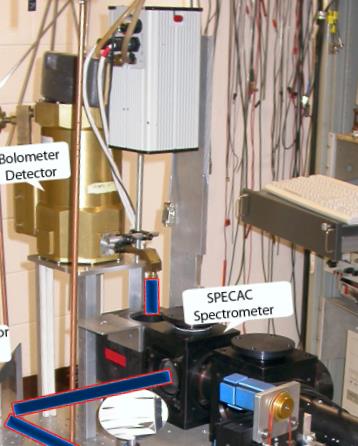 A SpecAc 4000 step-scan wire-grid polarizer FTIR spectrometer was extensively modified. The moving mirror was stabilized against wobble and a new stepper motor was installed. A 350W Oriel mercury vapor lamp and a He3 bolometer detector were integrated into the system, which enables measurements up to wavelengths of 2mm and a resolution of 0.1/cm. Custom software controls the movable mirror, records interferograms, and converts the interferograms to spectra applying user selectable filtering and apodization.
A SpecAc 4000 step-scan wire-grid polarizer FTIR spectrometer was extensively modified. The moving mirror was stabilized against wobble and a new stepper motor was installed. A 350W Oriel mercury vapor lamp and a He3 bolometer detector were integrated into the system, which enables measurements up to wavelengths of 2mm and a resolution of 0.1/cm. Custom software controls the movable mirror, records interferograms, and converts the interferograms to spectra applying user selectable filtering and apodization.
Voigt geometry cold-finger
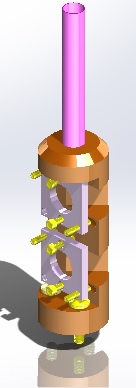 I designed and fabricated a Voigt geometry cold-finger with kinematic mounts for use in our Oxford magnet system. In this geometry, the B-field is in the plane of the sample that is perpendicular to the direction of light propagation. The E-field can be polarized parallel or perpendicular to the B-field.
I designed and fabricated a Voigt geometry cold-finger with kinematic mounts for use in our Oxford magnet system. In this geometry, the B-field is in the plane of the sample that is perpendicular to the direction of light propagation. The E-field can be polarized parallel or perpendicular to the B-field.
The cold-finger is used in conjunction with THz and MIR lasers as well as a Bomem FTIR continuous-scan spectrometer. The copper cold finger was machined using a 5-axis CNC directly from the Solid Works 3D model (via CAM software). The thin-wall 316 stainless steel alignment pin is soldered into the copper cold finger that mates with a custom-made collet mounted to the 77K shield. Two samples may be mounted simultaneously. Mirrors are fabricated gold-coated silicon wafers. All components are non-magnetic. Included wire routing allows simultaneous dc measurements and gating while performing optical reflection measurements as well as typical Cernox 4-probe themometry.
Mechanical Drawings - Oxford Voigt Cold Finger
Miscellaneous hardware
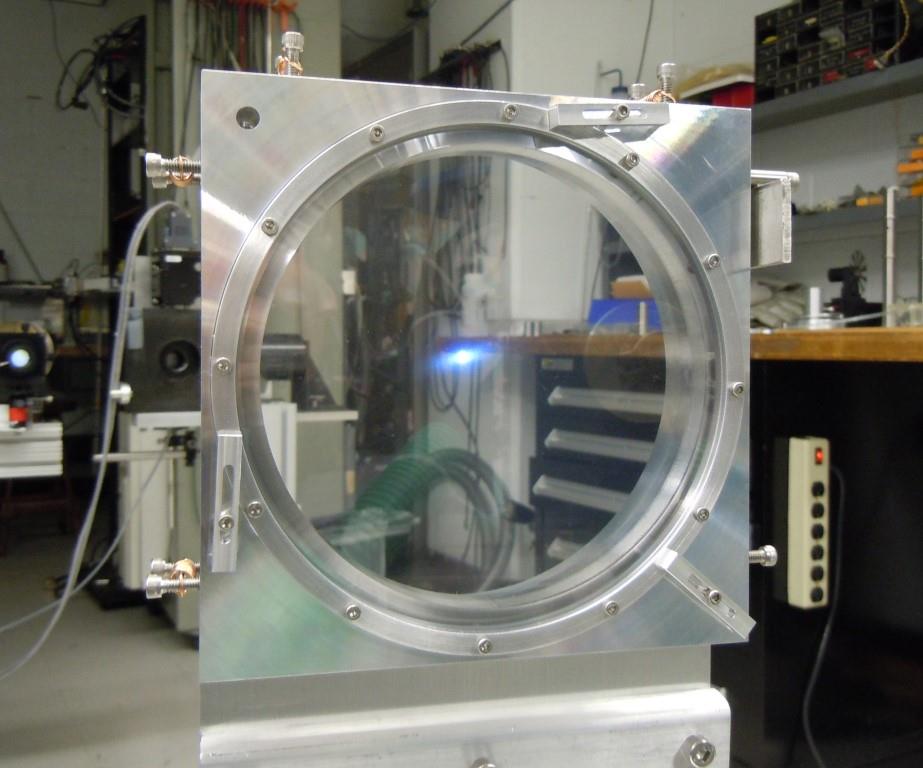 Most of the THz optical hardware is custom built due to the large beam diameter and proximity to high magnetic fields. An example is the beam splitter used in Kerr measurements. A large diameter mylar pellicle is stretched over a circular knife edge with adjustable spring-loaded tensioners. The assembly is the front plate of a kinematic mount with hand-wound phosphor-bronze wire extension springs.
Most of the THz optical hardware is custom built due to the large beam diameter and proximity to high magnetic fields. An example is the beam splitter used in Kerr measurements. A large diameter mylar pellicle is stretched over a circular knife edge with adjustable spring-loaded tensioners. The assembly is the front plate of a kinematic mount with hand-wound phosphor-bronze wire extension springs.
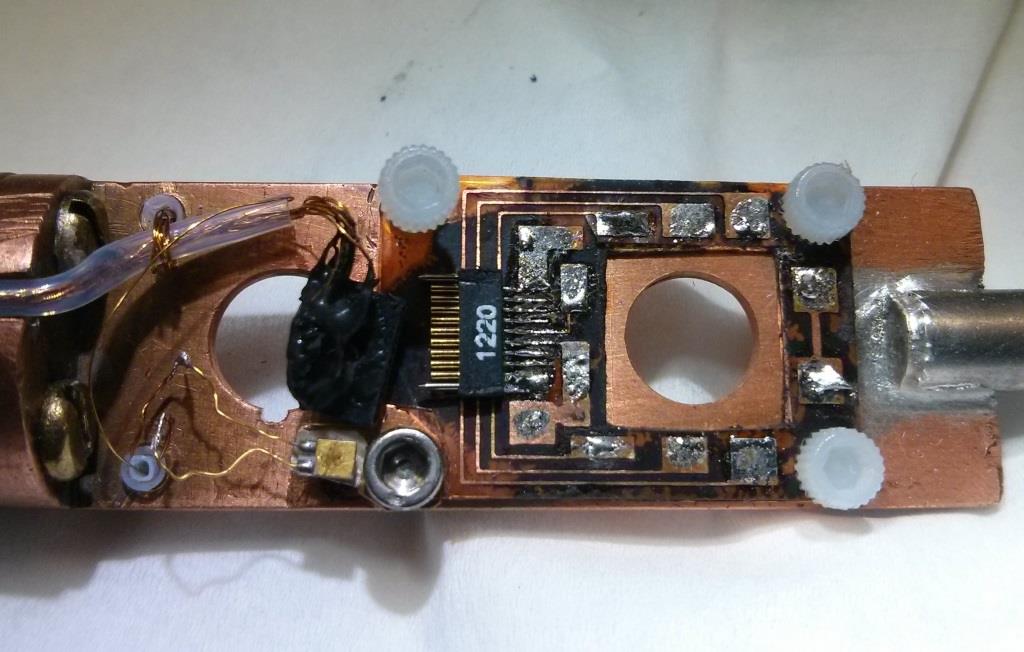 The Faraday geometry cold-finger for the 8T magnet is outfitted with a tiny Omnetics neurological connector soldered to a custom fabricated Pyralux (copper coated kapton) connector mounted on a copper plate with an optical aperture. The assembly allows up to 10 wired connections to the sample for dc-transport measurements concurrently with optical measurements.
The Faraday geometry cold-finger for the 8T magnet is outfitted with a tiny Omnetics neurological connector soldered to a custom fabricated Pyralux (copper coated kapton) connector mounted on a copper plate with an optical aperture. The assembly allows up to 10 wired connections to the sample for dc-transport measurements concurrently with optical measurements.
 A 4" diameter light pipe couples a Bomem DA-8 spectrometer to an 8T Oxford magnet. The evacuated light pipe eliminates water absorption in the far infrared spectral region. Custom vacuum windows and mounting hardware separate the spectrometer vacuum from the low vacuum in the cryogenically maintained magnet. A parabolic mirror in the pipe focuses a columnated beam from the spectrometer to a sample that resides inside an Oxford magnet. The reflected light is collected by the same parabolic mirror and columnated. A beam splitter or half-mirror inside the spectrometer redirects the reflected beam to detectors that attach to standard ports on the spectrometer. The custom piston-like coupler with o-rings seals to the magnet housing and enables alignment while under vacuum. The coupler allows 6-degrees of freedom adjustments (3x translational, 3x rotational).
A 4" diameter light pipe couples a Bomem DA-8 spectrometer to an 8T Oxford magnet. The evacuated light pipe eliminates water absorption in the far infrared spectral region. Custom vacuum windows and mounting hardware separate the spectrometer vacuum from the low vacuum in the cryogenically maintained magnet. A parabolic mirror in the pipe focuses a columnated beam from the spectrometer to a sample that resides inside an Oxford magnet. The reflected light is collected by the same parabolic mirror and columnated. A beam splitter or half-mirror inside the spectrometer redirects the reflected beam to detectors that attach to standard ports on the spectrometer. The custom piston-like coupler with o-rings seals to the magnet housing and enables alignment while under vacuum. The coupler allows 6-degrees of freedom adjustments (3x translational, 3x rotational).
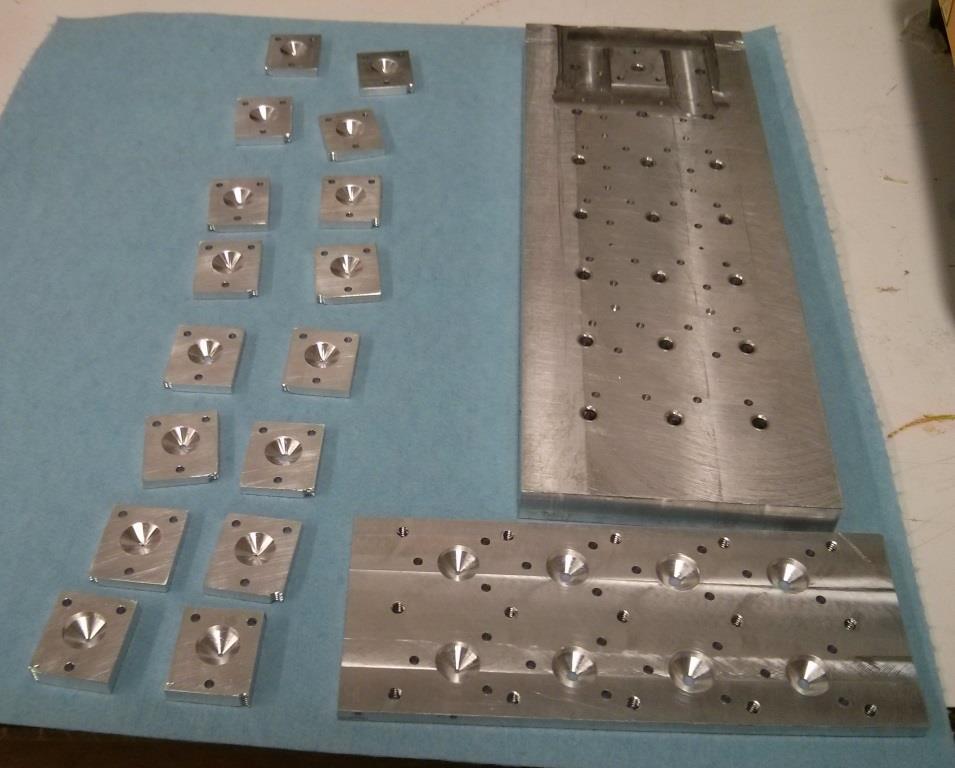 Identical pairs of various diameter optical apertures were fabricated using a 3-axis programmable CNC mill to a requisite accuracy of 0.0001". The conical sections are coated with a mixture of resins and carbon soot, maintaining perfect knife-edges along the aperture opening.
Identical pairs of various diameter optical apertures were fabricated using a 3-axis programmable CNC mill to a requisite accuracy of 0.0001". The conical sections are coated with a mixture of resins and carbon soot, maintaining perfect knife-edges along the aperture opening.
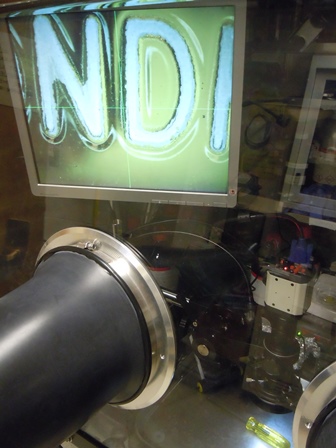 An imaging system with magnification installed in an inert glove box enables mounting sub-mm hygroscopic Na3Bi crystals to custom optical mounts. A magnifying lens system with a large working distance focuses onto a CCD camera connected to a SVGA monitor. The system has a resolution of 5 um. The handle of a ball-driver is shown with an intermediate magnification setting, each letter being approximately 2mm in width.
An imaging system with magnification installed in an inert glove box enables mounting sub-mm hygroscopic Na3Bi crystals to custom optical mounts. A magnifying lens system with a large working distance focuses onto a CCD camera connected to a SVGA monitor. The system has a resolution of 5 um. The handle of a ball-driver is shown with an intermediate magnification setting, each letter being approximately 2mm in width.
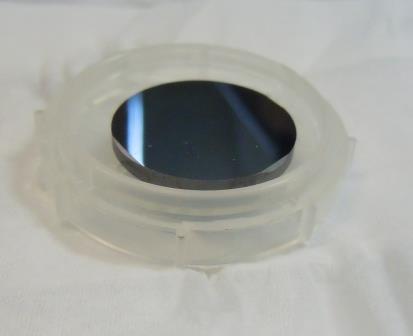
A brass cutting tool was fabricated for a drill press to grind-cut sets of vacuum and cold windows for an optical cryostat from a 4mm thick <100> silicon wafer. The windows have a high transmission over a broad spectral range in the far- and mid-infrared.
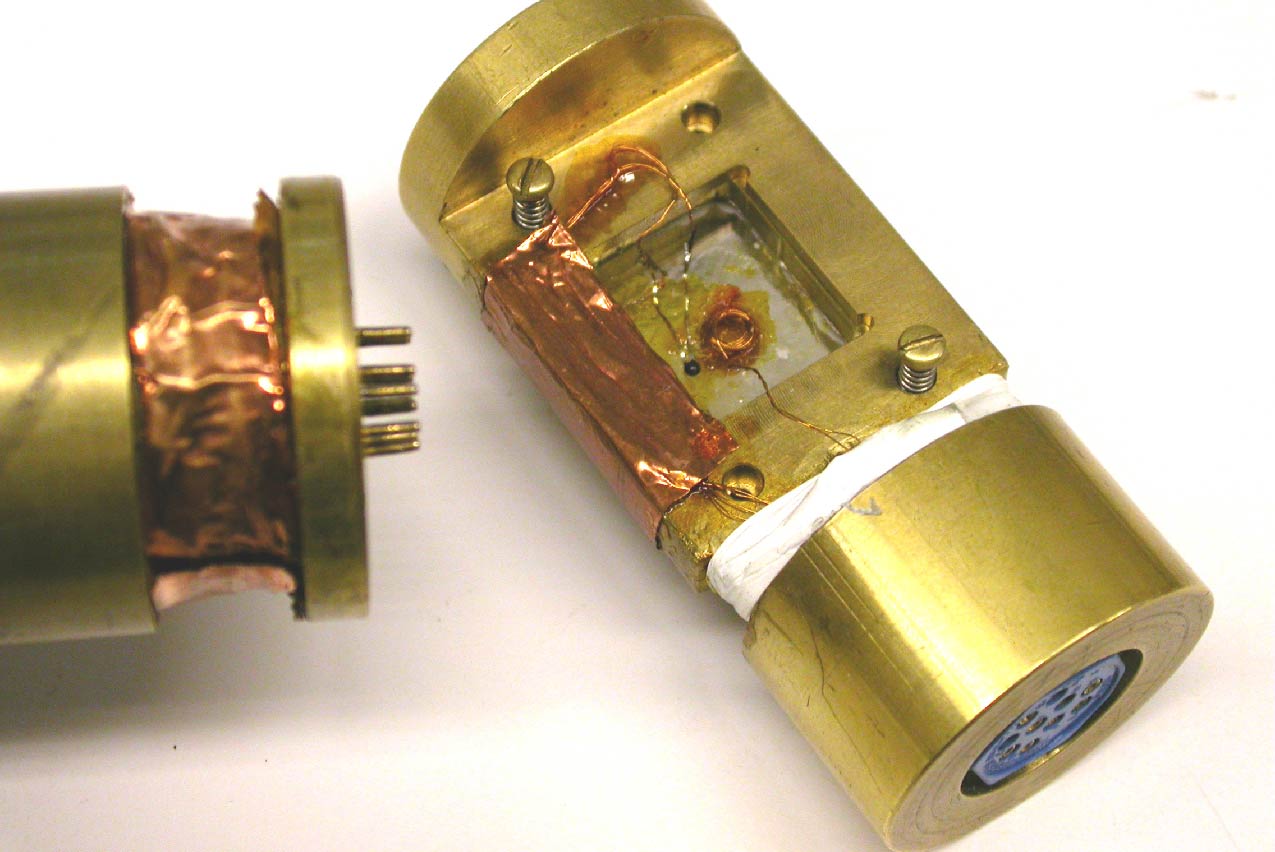 A probe designed to dip into narrow-mouth mobile liquid helium dewars measures sample properties as a function of temperature from room temperature down to 4.2K. The fabricated probe was designed with three modular swappable heads that measure the ac-magnetic susceptibility and dc transport properties of samples and calibrates thermometers.
A probe designed to dip into narrow-mouth mobile liquid helium dewars measures sample properties as a function of temperature from room temperature down to 4.2K. The fabricated probe was designed with three modular swappable heads that measure the ac-magnetic susceptibility and dc transport properties of samples and calibrates thermometers.
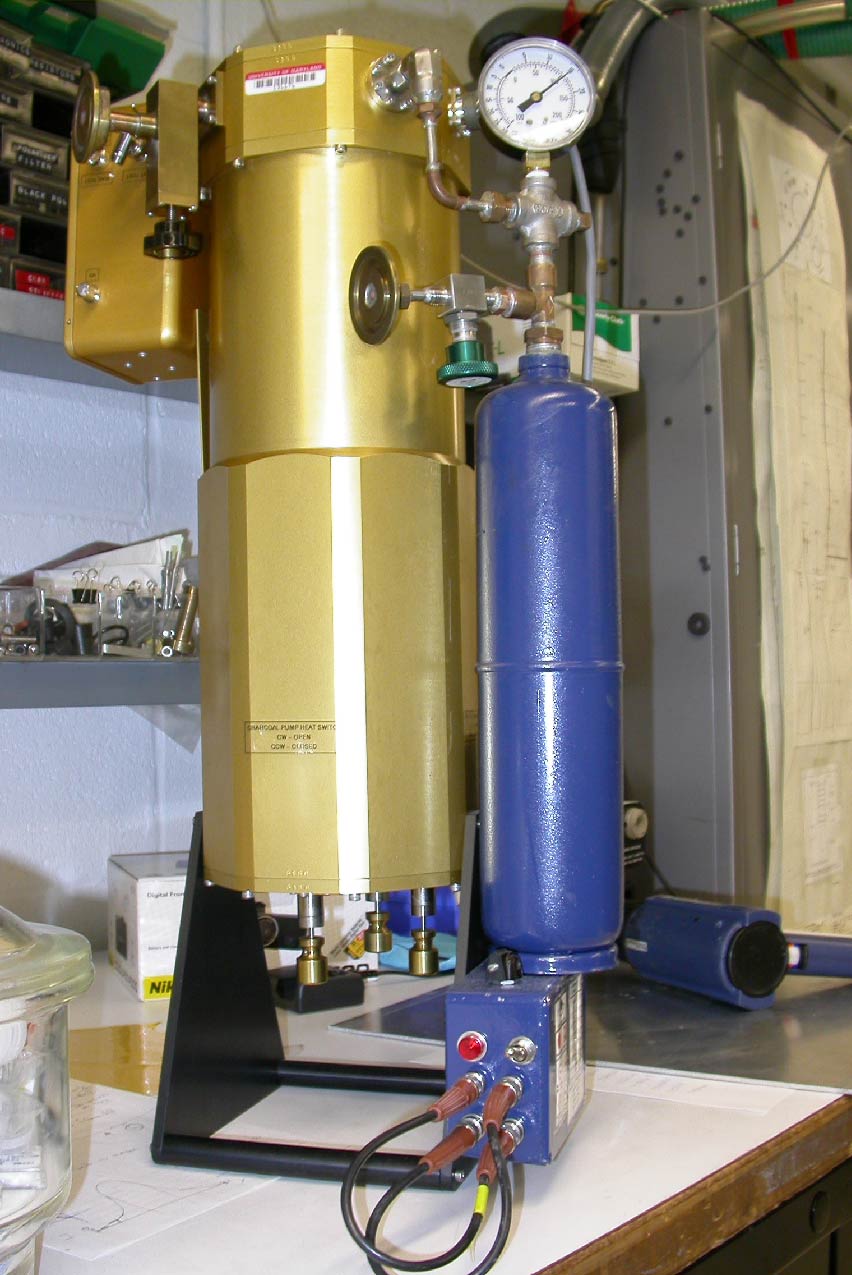 A helium-3 (He-3) gas system was built for a low temperature bolometer detector. The bolometer cryostat has a liquid nitrogen shield, a He-4 cold stage that is chilled to 1.7K, and a He-3 cold stage that reaches 320 mK when an internal charcoal sorption pump is activated. The fabricated blue tank assembly is charged with He-3 using a fabricated external gas exchange system that evacuates and stores He-3 with zero loss. A control box at the bottom includes a variable heater controller and houses electronics for convenient measurement of multiple thermometers.
A helium-3 (He-3) gas system was built for a low temperature bolometer detector. The bolometer cryostat has a liquid nitrogen shield, a He-4 cold stage that is chilled to 1.7K, and a He-3 cold stage that reaches 320 mK when an internal charcoal sorption pump is activated. The fabricated blue tank assembly is charged with He-3 using a fabricated external gas exchange system that evacuates and stores He-3 with zero loss. A control box at the bottom includes a variable heater controller and houses electronics for convenient measurement of multiple thermometers.
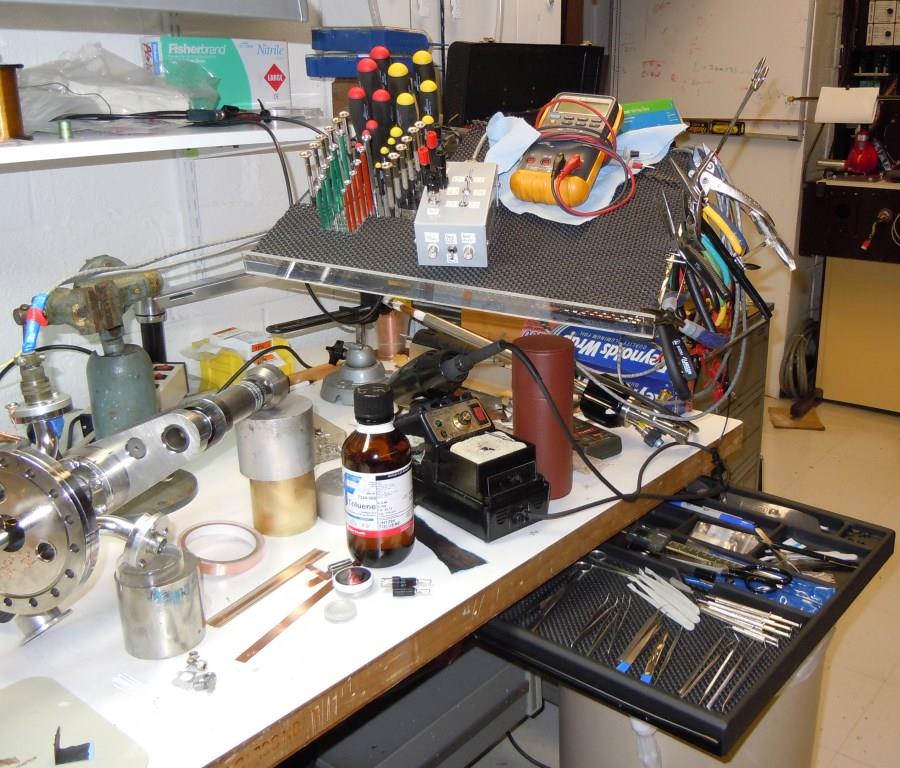 The laboratory is equipped with an attached shop for machining and hot-works (soldering/brazing/welding). A large variety of specialized work is performed on my laboratory bench, from microscopic sample fabrication to cryostat modification. While designing my own workspace, I found it very helpful to see other peoples' work areas. In the spirit of reciprocity, two pictures are posted which solved work-space problems for my special set of circumstances.
The laboratory is equipped with an attached shop for machining and hot-works (soldering/brazing/welding). A large variety of specialized work is performed on my laboratory bench, from microscopic sample fabrication to cryostat modification. While designing my own workspace, I found it very helpful to see other peoples' work areas. In the spirit of reciprocity, two pictures are posted which solved work-space problems for my special set of circumstances.
Jewelers' benches have many closely-spaced flat surfaces, tools that are within arm's reach, and a work-piece positioned very close to the body's torso for maximum arm and hand stability. This is in contrast with large scale items that require a large open flat surface. I needed a floating surface, packed with tools, that is adjustable in position, height, and angle, which is nearby when working on small 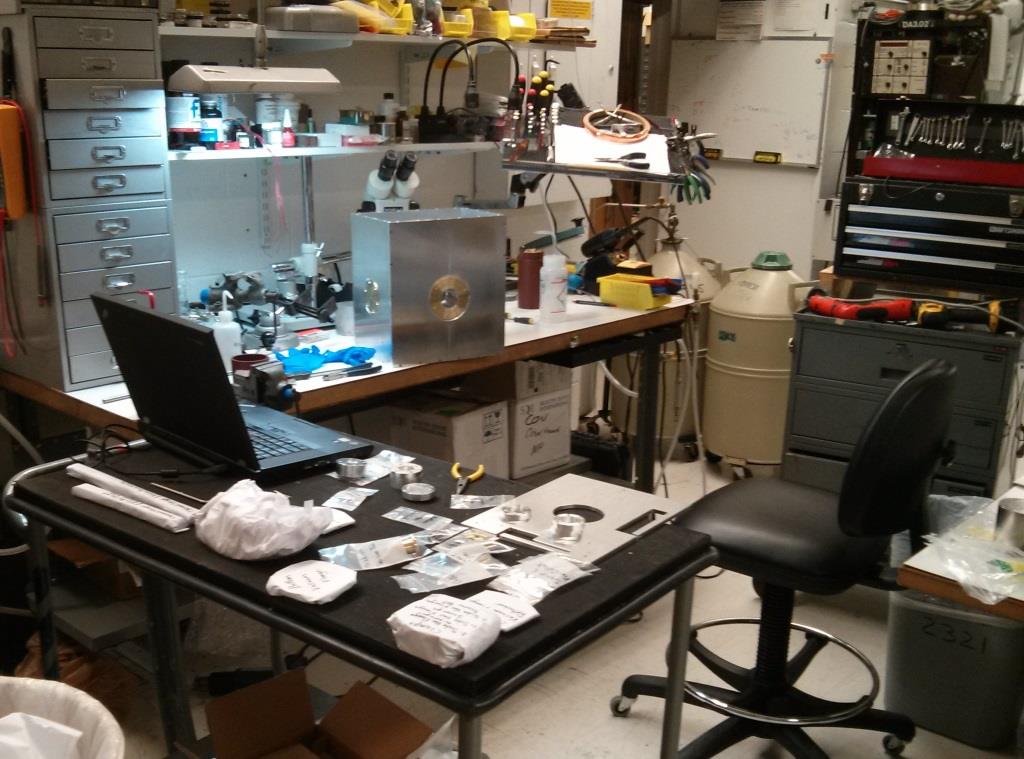 items and swung out of the way when working on larger ones. The floating platform is made from Lexan (polycarbonate) to allow light to propagate to the benchtop, and is positioned by a long, heavy-duty computer monitor arm. Other surfaces include a set of long shallow drawers on the left of the bench and one wide shallow drawer on the right with many small tools. Nitrile gloves, shop towels, and kimwipes are mounted underneath the bench. A variety of wire cutters, plyers, tweezers, knives, picks, vices, screwdrivers, ball/hex drivers, files, multimeter, soldering iron, and heat-gun are within arm's reach. Binocular magnifiers with variable magnification (up to 30x) has a large working distance and is conveniently swung into position.
items and swung out of the way when working on larger ones. The floating platform is made from Lexan (polycarbonate) to allow light to propagate to the benchtop, and is positioned by a long, heavy-duty computer monitor arm. Other surfaces include a set of long shallow drawers on the left of the bench and one wide shallow drawer on the right with many small tools. Nitrile gloves, shop towels, and kimwipes are mounted underneath the bench. A variety of wire cutters, plyers, tweezers, knives, picks, vices, screwdrivers, ball/hex drivers, files, multimeter, soldering iron, and heat-gun are within arm's reach. Binocular magnifiers with variable magnification (up to 30x) has a large working distance and is conveniently swung into position.